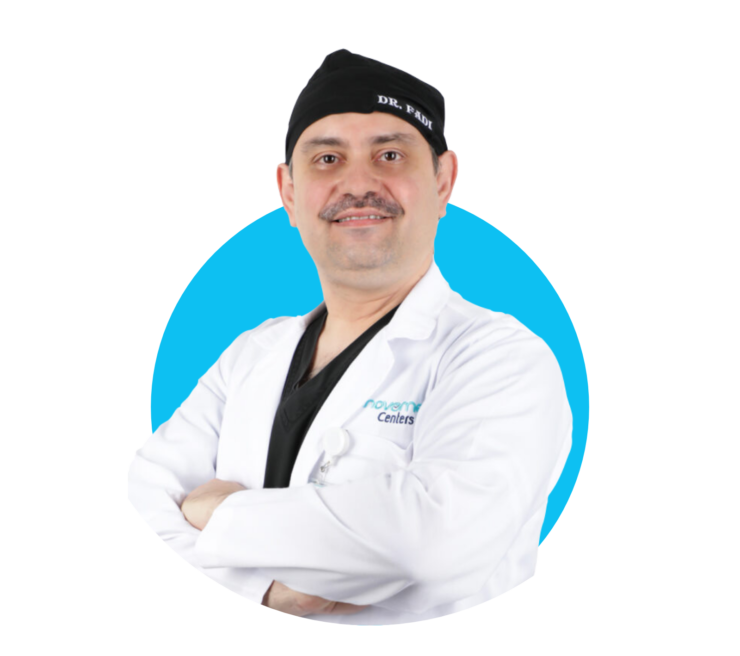Hair Loss Treatment in Dubai, Abu Dhabi and Al Ain
The most common cause of hair loss in both males and females is hereditary hair loss, caused by the hormone dihydrotestosterone. Also known as male-pattern baldness, female-pattern baldness or androgenetic alopecia, it affects more than 90% of males and 40% of females.
Males who experience hair loss will typically lose it from the top of their head, leaving a horseshoe shape around the back and sides of the head. These areas, where the hair remains, become the donor sites. This hair displays ‘donor dominance’, it is programmed genetically to not fall out. Even when transplanted, these hair follicles will be stable and should grow as well at the recipient site as they did in their original location. Females usually demonstrate a more diffuse thinning of their hair over the entire scalp. This is a lot more difficult to treat with transplant as the remaining hair is weaker and if these follicles are transplanted they are unlikely to be stable enough to continue growing.
Therefore, women are less likely to make suitable candidates for hair transplants. However, if you are female and are concerned about hair loss, please visit our clinic to discuss other options, including laser therapy, micropigmentation and PRP.
Other forms of hair loss include non-hormonal traction alopecia (caused by a regular pulling force on the hair strands), hair loss at any sites of surgical incision, and trauma-induced hair loss (caused for example, by burns, scarring or chemicals). If you have experienced any of these you may benefit from hair transplantation, so speak to our experts today.
Dr Fadi is also adept at facial hair transplantations; enhancing eyebrows, sideburns, mustaches and beards as required.
To ensure that you are a viable candidate for hair transplantation our expert dermatologist will first conduct a thorough consultation. He will perform blood tests and scalp biopsies to look for underlying causes of hair loss and possible infections. He will remove several dozen hairs and examine them under a microscope to check the quality and condition of the hair shaft. He will also take a comprehensive medical and family history, as hair loss is very often hereditary.
This preliminary checkup will enable Dr Fadi to identify which hair transplantation process will be most suitable for you.
FUT
Follicle Unit Transplantation (FUT), or strip hair transplant surgery, is a common technique in use today. A local anesthetic is applied to numb the scalp. We can also provide a mild sedative if you are particularly anxious. A 6-10-inch strip of skin is removed from the back of the head. Our experienced staff will then use stereo-microscopes to meticulously dissect individual follicular units. Usually between 500 and 2000 mini grafts are created. Excess fibrous and fatty tissue is removed from each graft. The scalp is stitched closed, leaving a thin linear scar. This small scar will most likely be hidden by your own hair.
FUE
Follicular Unit Extraction (FUE) is also performed under local anesthetic, with or without sedation. In this technique, individual hair follicles are removed from the back of the scalp. A mini graft will contain 2-4 hairs and a micro graft will contain 1 or 2 hairs. Each follicular unit that is removed leaves a tiny punch mark of 0.6-1.0mm diameter, no stitches are required, and the punch marks are covered up by your own hair. This process takes substantially longer to complete but may be preferable if you favor a close-cropped hair style as there will be no visible scarring. Additionally, with no stitches to remove, the recovery period tends to be quicker; a matter of days rather than a couple of weeks.
Body hair transplantation
If the hair on the head is of poor quality, hair from elsewhere on the body, for example, from a beard or the chest, can be used instead. FUE is used to excise these hair follicles. This is most useful when the area that requires coverage is small.
Whilst extraction processes differ, the actual transplantation process is the same for FUT and FUE:
- The area where the hair will be transplanted is cleaned and numbed.
- Small micro blades or very fine needles are used to make puncture ‘recipient’ sites. The spacing and density of these is predetermined to ensure that the final result is as realistic as possible.
- Each follicular graft is ‘planted’ in a hole.
- Over 50 grafts are planted per squared cm of scalp/face.
- Typically, hair grafts at the front of the hairline will contain 1-3 hairs each, those further back will contain more hairs per graft.
- To ensure healthy circulation is maintained, each graft is positioned carefully so that it is surrounded by healthy skin. The spaces can be filled at a later date with additional grafts.
Post-operative care includes wearing a pressure bandage for a few days and careful shampooing to prevent scab formation around the transplant sites. Scabs could damage the freshly transplanted follicles.
The number of hairs transplanted will depend on how large your area of hair loss is. If you want to hide a relatively small surgical incision you may only require several hundred grafts. Each one containing between one and four individual hairs. This can be performed in a single session.
For larger areas of hair loss, as is seen with androgenetic alopecia, you may require up to 3000 individual grafts. Multiple sessions, split over different days, will be necessary.
Dr Fadi’s patients often ask him how painful a hair transplant will be. The answer is that for both FUT and FUE it is more a matter of discomfort than pain.
“When you read about the procedure, it seems a bit gruesome – but the fact is, there’s no pain with the surgery – rather, it is comparable to getting a filling at the dentist… The discomfort comes from being in the chair for up to ten hours for the entire process to be completed. We do try to alleviate this by giving you regular breaks.”
Prior to starting the treatment, a local anesthetic is applied so there’s no pain. Post-op, there may be some mild pain where the stitches are (FUT), or where the grafts have been inserted, but over-the-counter painkillers should be sufficient to manage this.
Hair transplantation is not a quick process. The meticulous nature of the technique and the desire to get as natural a final result as possible, can mean hours, if not a couple of days, spent in the treatment chair.
We will do all we can to alleviate any discomfort you feel during this time.
As a process FUE takes longer to complete than FUT. Total treatment time will also be dependent on the size of the transplant. To get the optimal outcome and a fullness akin to a natural head of hair, it is likely that several sessions will be required, with a healing interval of a couple of months between sessions. This ensures that each graft can be placed in an area of healthy skin, maximizing the chances of successful hair regrowth. Treatment timelines and schedules will be discussed with you during your preliminary appointments.
As the procedure is performed under a local anesthetic, recovery times afterwards are fairly rapid. Any effects of the anesthesia are likely to have worn off after a couple of days. Minor swelling and slight pain may persist but can be managed with over-the-counter medications.
Two to three weeks after a hair transplant it is normal for the transplanted hair to fall out. This is nothing to be worried about, as the transplanted follicles should start growing new hairs to replace the lost ones. It is worth noting that, in general, hair growth is quite a slow process and the initial signs of regrowth can take anything from three to four months, depending on the hair’s natural growing cycle. This differs from person to person.
Accordingly, as your hair starts to grow at it’s regular rate, it can take up to eight months for new growth to really be visible. We would hope that by one year post-op, you will see the full effect of your transplant.
A frequent question we get asked is whether everyone will know that you’ve had a hair transplant during the regrowth period. The most obvious way to avoid unwanted questions is to cover your head. If you do not do this, we would recommend a three week recovery period, by which time the most noticeable signs that you have undergone a procedure will be lost. It is important to bear in mind that for both FUT and FUE the area involved in the transplant will be shaved prior to treatment to provide the correct surgical environment and to protect your existing ‘healthy’ hairs. Thus, if you do not already wear your hair in a close-cropped style, there will be an inevitable change in appearance.
After the procedure, as your hair begins to grow in, you may find people asking if you’ve lost weight. This is normally because they have noticed something different about you but cannot pinpoint exactly what has changed. This indicates to us a successful treatment, as we have enhanced your appearance, but maintained a natural looking finish.
Associated risks
Hair transplants are largely risk-free. You can be assured that by trusting your care to our highly experienced team, the process is likely to go without a hitch. In rare cases there may be some bleeding, or risk of infection. Antibiotics are often prescribed post-surgery to minimize the chances of this. Occasionally patients may experience unnatural-looking new growth or shock loss (sudden loss of your original hair). Over time this should settle down; the new hair will start to resemble the surrounding, original hair and any shock loss should be temporary.
Post-hair transplant care
Following a hair transplant, it is normal to be prescribed medication to minimize hair loss. The two most commonly used are minoxidil (Rogaine) and finasteride (Preopecia).
Minoxidil is a liquid that is rubbed into the scalp to stimulate hair growth. Finasteride is a pill, taken daily. It slows hair loss but is less effective in men over the age of 60, who may benefit more from minoxidil treatment. These treatments should slow down or prevent further hair loss, enhancing the effects of your transplant and hopefully reducing the likelihood of needing further surgery.
Another option is to undergo PRP therapy. Platelet-rich plasma is extracted from your own blood and injected into your scalp. This stimulates the hair follicle cells to grow hair. PRP therapy is not the same as stem cell therapy, but the platelets will accelerate the activity of stem cells located in your scalp.
We will discuss the options for further, follow-up treatment with you after your transplant.



